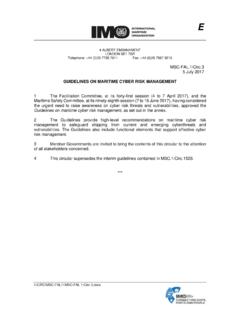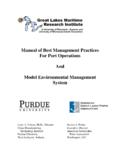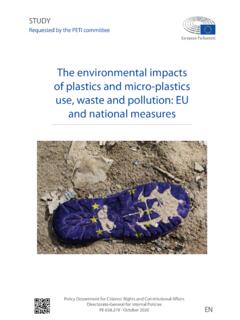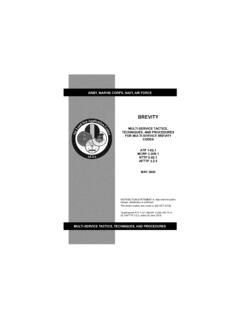Transcription of Safety Management System Reference material
1 Safety Management System Reference material August 2010. maritime Safety Queensland, Safety Management System Reference material , August 2010 Page 1 of 93. Table of contents Section 1: Introduction .. 6. Safety Management Systems .. 6. Ship's profile and lines of responsibility .. 6. Safety and emergency planning .. 6. Operational manual .. 7. Technical manual .. 7. Maintenance and service manual .. 7. Crew records and training .. 7. Certificates .. 7. Assessing and managing risk .. 7. Relevant legislation, rules and standards .. 8. Section 2: Ship profile and lines of 9. Ship's 9. Lines of 9. Owner or operator .. 9. Record of hazardous occurrences .. 9. Record of client and crew compliments and complaints .. 9. Record of annual review.
2 10. Section 3: Safety and emergency 11. Safety equipment .. 11. Frequency of drills .. 11. Special 11. Emergency 11. Communications 11. Danger messages or securit .. 12. Communicating 12. Emergency plans .. 13. Verbal emergency plans .. 13. Person 14. Fire 14. maritime Safety Queensland, Safety Management System Reference material , August 2010 Page 2 of 93. Fire control plans (for ships greater than eight metres) .. 14. Portable 16. Engine room fires .. 16. Severe weather .. 16. Assembly stations .. 17. Emergency station list's and escape 17. Collision/grounding/flooding .. 18. Abandoning ship .. 19. Medical emergency .. 19. Missing person/overdue tender or dory .. 20. Section 4: Operational 22. Ship operations.
3 22. 22. Operating procedures .. 28. Sailing and pre-departure checks .. 30. Passenger briefing .. 31. Passenger manifest .. 31. Maintaining a radio watch .. 31. 32. Safety of 33. Route planning and position 34. Anchoring .. 34. Mooring .. 35. Transfer of people to or from the 35. Disposal of sewage .. 35. Disposal of waste oil .. 37. Disposal of garbage .. 37. Minimising noise pollution .. 37. Confined space entry procedures .. 37. Watertight integrity .. 37. Dangerous goods and hazardous material .. 37. maritime Safety Queensland, Safety Management System Reference material , August 2010 Page 3 of 93. Operating lifting 38. Cargo and load 38. Operation of the ship's tenders and dories .. 38. Laying and retrieving fishing apparatus.
4 39. 39. 40. Participating in search and rescue activities .. 40. Safety gear packs .. 40. Use of an emergency position indicating radio beacon .. 41. Hints for Safety at sea .. 41. 41. Refuelling or bunkering .. 42. Steering gear and emergency steering 44. LP gas systems for appliances and for engines .. 44. Low voltage electrical plant and shore power supply .. 44. Specific operational 44. Fast craft vessels .. 44. F1 fast craft .. 45. F2 fast craft .. 48. Air cushion vehicles .. 56. Documents and records for fast craft that are neither F1 nor F2 fast 58. Wearing a lifejacket in high risk 58. Section 5: Technical manual .. 59. Technical manual .. 59. Section 6: Maintenance and service records .. 60. Maintenance and service schedules.
5 60. Maintenance and service record .. 60. Slipping records .. 60. Section 7: Crew levels and 61. Responsibilities of the ship's crew .. 61. Drills and emergency 61. maritime Safety Queensland, Safety Management System Reference material , August 2010 Page 4 of 93. Master .. 61. Engineer .. 62. Coxswain or 62. Short term crew training .. 62. Safety and communications .. 63. Number of 63. Minimum crew .. 63. Adequate crew .. 64. Crewing level guidelines .. 64. Crew training record .. 69. Communication and 70. Section 8: Certificates and documents .. 71. Certificates and other documents to be kept .. 71. Surveyor's reports .. 71. Section 9: Assessing and managing risk .. 72. Hazard checklist .. 72. Risk assessment .. 72.
6 Method of risk assessment: .. 73. Step 1 hazard identification .. 73. Step 2 assess and prioritise 75. Step 3 control of 76. Common hazards to consider .. 77. Step 4 implement control 78. Step 5 monitor and 78. Emergency scenarios with potential 78. Section 10: Glossary and acronyms .. 82. Glossary and acronyms .. 82. maritime Safety Queensland, Safety Management System Reference material , August 2010 Page 5 of 93. Section 1: Introduction Safety Management Systems To comply with Queensland law and the National Standards for Commercial Vessels, the owner and/or the master must keep and maintain operating documents that serve as a Safety Management System (SMS) for the following registrable ships: commercial ship over eight metres in length operating in Queensland waters, other than a ship operating in smooth waters that does not make voyages of more than 15 minutes duration fishing ship operating beyond partially smooth waters fishing ship that is not registered.
7 All other ships must keep particular documents as outlined in Schedule 4 of the Transport Operations Marine Safety Regulation 2004. The owner or master must ensure the required documents are: kept in a secure place on board ship, or if the ship is an open ship and it is impracticable to keep the records on board the ship, the documents must be kept at a prescribed place' that s accessible to the ship's crew complete, accurate and up to date kept with records for at least five years from the date they were made not defaced, entries erased or obliterated, destroyed or disposed of. Prescribed place' means either the owner or master of the ship having a place of business in Queensland for managing the ship's operations, or if not, then at that person's place of residence.
8 This document provides background and explanation about specific requirements of a Safety Management System . It should be used in conjunction with the example Safety Management System developed by maritime Safety Queensland in hard copy and CD ROM format. The hard copy version of the example Safety Management System contains Reference numbers that relate to sections of this Reference document. The documents required by Part 5, Division 11 of the Transport Operations (Marine Safety ) Regulation 2004 and by Part E of the National Standard for Commercial Vessels are: Ship's profile and lines of responsibility This section of the Safety Management System records basic details about the ship and outlines who is responsible for Management of Safety and pollution control.
9 Safety and emergency planning The owner and/or master are responsible for developing emergency plans to suit their particular vessel and to ensure crew are trained and practised in emergency drills. It is mandatory to develop emergency plans for the following situations: 1. person overboard 2. fire onboard 3. severe weather 4. collision and grounding 5. personal injury 6. assembly stations (for very small ships this will be a brief statement). 7. abandon ship Further plans must be developed for other possible emergency situations that are related to the nature of onboard operations. maritime Safety Queensland, Safety Management System Reference material , August 2010 Page 6 of 93. All training must be recorded in the training record section of the Safety Management System and/or in the ship's log.
10 These records must be produced for inspection by a shipping inspector. Operational manual This manual contains the procedures for all operations that will be conducted by the crew of the ship. It should outline roles and responsibilities and equipment to be used in a step by step guide for the master and crew. In the example Safety Management System , maritime Safety Queensland provided example procedures for the basic operations on a ship. The owner/master must change the examples to reflect the actual procedures used on their ship. They must also develop procedures for other activity conducted on the ship not covered by these examples. Tailoring this document in this way enables this document to serve as a compliant Safety Management System .






